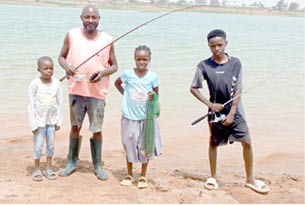Constructed in 1973 by the government for the purpose of water supply within Jos, the Plateau State capital, and environs, the Lamingo Dam is said to have a height of 15.7m, a length of 3.62km and a storage capacity of 90m3 (cubic meter).
But since its construction, the dam is yet to solve the water shortage problem experienced in Jos city from time to time, especially during the dry season.
Though some residents of Jos get their water supply from the dam, yet, residents of Lamingo in Jos North Local Government Area of the state and environs, who are closer to the dam, have lamented not enjoying water supply from the dam.
Nonetheless, the dam is not short of other human activities, even though some negate its original water supply purpose. Farmers have taken advantage of the dam to boost their dry season farming using the irrigation system which pumps water from the dam into their farms to nourish their crops/plants.
- 2027: Atiku, Obi’s alliance moves unsettle APC stalwarts
- Inside story of declining trade, rising poverty, banditry along Nigeria-Niger border
Miners also carry out their mining activities around the dam, and sometimes such activities, alongside other activities, contaminate the water.
Pastoralists also bring their cattle to graze around the dam, and they also use it as a source of drinking water for the cattle.
Others established block industries there so they can water their blocks when moulded, while food canteens, mechanic workshops and other business activities flourish around the dam.
With these series of activities going on around the dam, the water quality has been affected, thus resulting in varying degrees of chemical pollution of the dam, as well as dirt from domestic waste.
The pollution poses health hazards to residents and those who rely on the water for drinking, cooking and other domestic use.
This recently prompted the Jos Water Services Corporation to arrest and charge 44 persons responsible for the pollution of the dam in March this year.
The Managing Director of the corporation, Mr Apollos Samchi, who spoke after the arrest, said the activities of the miners, irrigation farmers and block moulders have resulted in the leak of various chemicals, heavy metals and mining materials into the water source, posing serious threat to the health of residents.
According to him, the 44 persons arrested by men of the National Security and Civil Defence Corps would soon be charged to court. He, however, called on the state government to erect a perimeter fence to secure the dam from encroachment.
Fishermen also come to the dam to fish. Many of them, however, engage in the fishing activities for fun, adventure, sightseeing, relaxation and related tourism attractions and occupational pastime, rather than for commercial purposes.
Our correspondent ran into one of such fishermen, Jonathan Gokir, who came from Bauchi Ring Road with his children to fish.
Gokir comes to the dam with his children to fish for fun sake because the children were on holidays and he wanted them to learn something fun and different from academic work.
On the inability of the dam to adequately supply water to the people, he said “That issue is the fault of successive governments who failed to utilize the potentials and the capacity of the dam.
“If the dam is put to good use, it won’t give room for unhealthy mining activities, irrigation, car and clothes washing, grazing of cattle, swimming, unnecessary fishing and other activities. If you look at the water very well, you can see that the mining activity is already contaminating the water as there are holes around the dam.
“People around the dam are supposed to be enjoying it but that is not the case. I therefore advice the government to explore the water and take advantage of its potentials to solve the water problem in parts of the state.
On his part, a resident of Lamingo, Azi Aware, said the dam was not serving any useful purpose for the people and communities around it. He however said it is often a death trap for some of their youths who go there to swim and get drowned.
Aware said the people of the area still use wells and streams as their sources of water, except a few boreholes dug by privileged individuals for their water supply.
He said the dam connects two other smaller dams from Shere Hills from where water flows into the big Lamingo dam also, as well as other connecting streams in the areas.
The resident said there are no pipes laid from the dam to people’s houses in Lamingo, adding that the water is mostly drawn from the dam to the water board than it is supplied from the water board back to Lamingo communities.
He said the government only needs to put few things in place to make the dam fully useful to the people of the community, adding that a water treatment plant can be constructed around the dam to make it easier for the water to be treated, and distributed to homes via already laid pipes.
That, he said, would be easier for the water to be distributed to the community rather than drawing the water from the dam to water board which is several kilometres away to treat it before distributing to the community.
Another resident of Lamingo, who farms around the dam, Atong James, said the they are enjoying the dam for irrigation purposes.
She said the water that is supplying their area is from Shen dam around Du area of Jos South, and not even from Lamingo dam.
Atong explained that the narrative about water not being supplied to Lamingo area is because Lamingo is on a hill and the water board is on a slope, so water can easily be pumped from Lamingo dam to the water board for treatment, but difficult to be supplied back to the communities around Lamingo because it is difficult to pump water from a position downwards to upwards, than the other way round.
According to her, they use a well in their house, and they installed a water pumping machine in the well to supply water to the rooms for domestic use.
She then called on the authorities/corporation to deepen their efforts beyond arresting people who pollute the dam to making sure that everything possible is done to make the dam meet the water needs of the people via pipe borne water.
Reacting, the Managing Director of Jos Water Services Corporation, Apollos Samchi, said the problem has been overtime, but firstly that the dam wasn’t constructed then to carter to the water needs of the entire Jos city but for specific areas within the city, especially the mining community then, and there has been population explosion in the city.
That is why, he said, the dam only carters for about 20 percent of Jos water supply, and that the bigger dam that caters for the 80 percent of Jos water supply, Lamingo community inclusive, is the Shen Dam, which he said is officially called the Yakubu Gowon Dam.
Also, the managing director clarified the nomenclature of the Lamingo Dam, saying its official name is Liberty Dam and not Lamingo Dam as it is generally known.
Nonetheless, he said what makes a dam effective in meeting up with water supply to the city is the ability to provide water from plants to various households.
Samchi said the existence of the dam does not automatically translate to water availability/supply because the dam is just a raw material that requires processing via treatment plant to become finished product (water) that is consumable.
According to him, tackling the water situation in Jos is a major focus of the Caleb Mutfwang’s administration, and he is working so hard to resolve the situation.
He further explained that lack of proper attention to the water sector by successive administrations over the years also contributed to the problem, and so most of the machines in the treatment plants and the underground connecting pipes are either faulty, obsolete or rusty.
The managing director added that in addition to the rusty or faulty pipes underground, road construction has also affected the pipes as some contractors bust the pipes during construction without any recourse to the water corporation.
He added that they (the corporation) have made conscious efforts towards the repair of the dam since his assumption of office about five months ago, and as time goes, their efforts would be made known and also felt by the people.

 Join Daily Trust WhatsApp Community For Quick Access To News and Happenings Around You.
Join Daily Trust WhatsApp Community For Quick Access To News and Happenings Around You.


